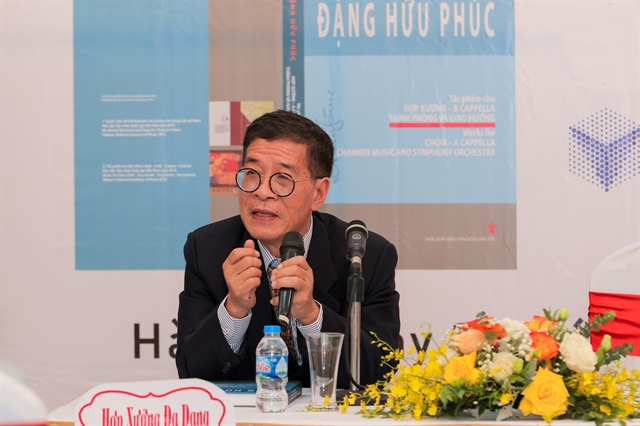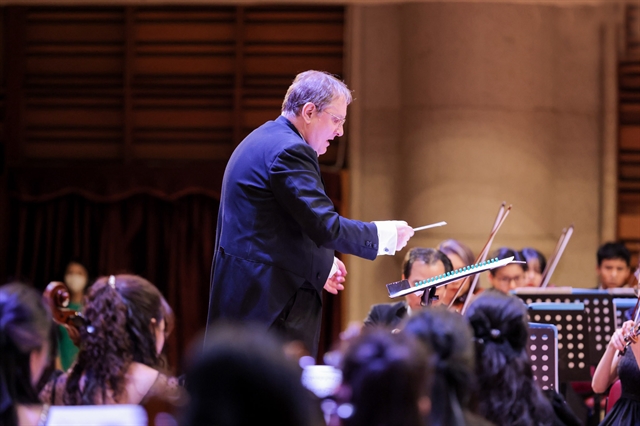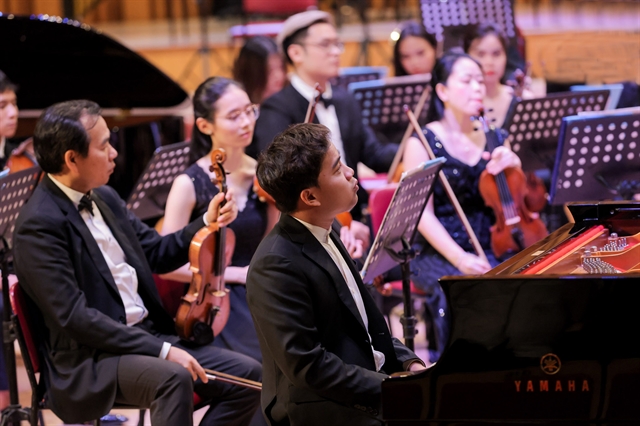(Báo Việt Nam News) The conductor of the night, Maestro Wojciech Czepiel, came back to town after his last time conducting pianist Nguyễn Việt Trung in 2018. Czepiel has been an influential composer and conductor in Poland.

HÀ NỘI — Still going strong at 70 years of age, composer Đặng Hữu Phúc has launched a full collection of his orchestral works, including chorus singing, acapella, chamber and symphony orchestra, made possible with sponsorship from the Vingroup’s VinIF foundation on Saturday night.
This collection comprises his first work in 1973 and the latest pieces he wrote last year.
“I am particularly delighted to hear my works played by the Hà Nội Philharmonic orchestra,” Đặng Hữu Phúc told Việt Nam News prior to the book launch, followed by a concert featuring a Polish duo, conductor Maestro Wojciech Czepiel and pianist Nguyễn Việt Trung, who flew in for the event celebrating Poland’s National Day.
“It’s each and every composer’s wish, not just myself, to have their hand-written works published and then played by other musicians, which is the most important and vital to a composer,” he added.
Having studied chèo (popular opera) and lên đồng (entering a trance) for a long time, in 2019, he wrote the dances of chèo and lên đồng, signature folk music and ceremonial ritual music of northern Việt Nam, which had their world premiere by the Hà Nội Philharmonic.

During his career, Phúc had two other books published, one Romance Collection works for voice and the other for Piano performance.
Speaking at the book launch, Phan Thị Hà Dương, deputy director of the VinIF Foundation, said: “VinIF has been honoured to sponsor this publication, which is perhaps the first orchestral book collection for the first time in Việt Nam.”
The book will help music lecturers and students in their work and further international cooperation with artists worldwide.
Launched in 2018, the VinIF Foundation made its mission to support science and technology projects in the digital era in Việt Nam and the world.
“We at the VinIF have realised that other cultural and historical values must be preserved and protected. And we have the first hybrid cooperation between technology and arts.
People’s Artist Quang Thọ, a leading tenor and voice pedagogue, said he’s been teaching Phúc’s works to students, which had been made easier thanks to Phúc arrangement for piano accompaniment.

Music critic Nguyễn Thị Minh Châu said this book should be the hope for other orchestral works of Vietnamese classical music composers to get published.
“We had a project to publish the earliest works, but it stopped with composers born in the 1930s. So this is great news for the author, the music circle, and the public.”
Pianist Nguyễn Huy Phương said: “Đặng Hữu Phúc was trained in piano performance, so the music he wrote was very solid with accompaniment for performance. This dance of chèo and lên đồng has the right hand playing the traditional tunes of pentatonic scales of Vietnamese or oriental music. In contrast, the left hand plays the heptatonic scales of western music of an accompanying orchestra. Both are very different, but still intertwined in a coherent composition, structure and music flow.”

The conductor of the night, Maestro Wojciech Czepiel, came back to town after his last time conducting pianist Nguyễn Việt Trung in 2018. Czepiel has been an influential composer and conductor in Poland.
Trained as a violinist, he has developed his violin repertoire to expand beyond classical and conducted various orchestras where his excellent education and talent shone, according to Polish music professor Krzysztof Penderecki.
Based and trained in Poland, Nguyễn Việt Trung represents the best combination both Việt Nam and Poland had to offer. Having competed in the 20th International Chopin Piano Competition in 2021 and got to the second round, Trung has made his name one of the young piano talents touring not only Poland and Việt Nam but also the world. — VNS.
Bài viết trên Báo Việt Nam News

